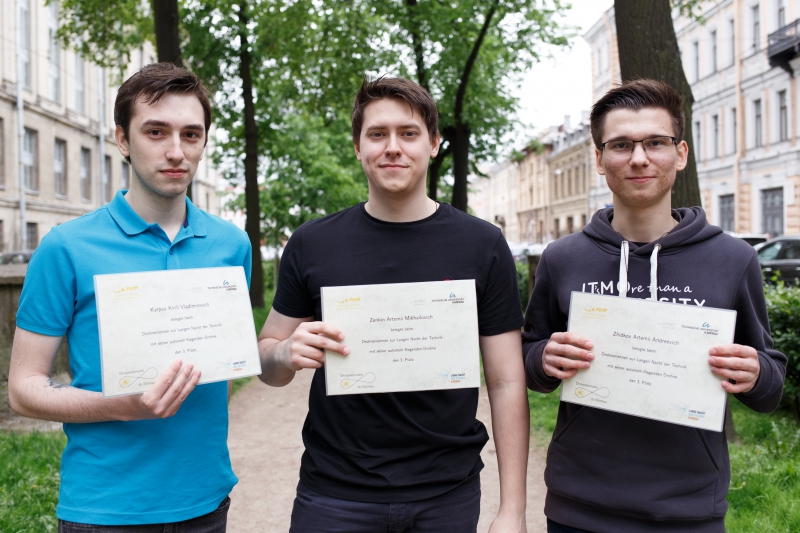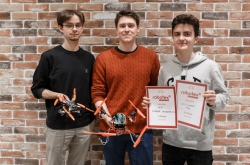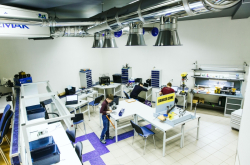The 2019 Mile of Technology marks the fifth-year milestone for the competition. As per the tradition, the robotics tournament is held on the premises of the Ilmenau University of Technology (TU Ilmenau), prefacing the Long Night of Technology, a science and tech extravaganza gathering over 15,000 spectators each year.
The organizers extended a special invitation to ITMO University’s team, who participated in the competition’s drone races. This track is hosted by the robotics project Forschungsgemeinschaft elektronische Medien e.V., one of the biggest student associations in the German state of Thuringia, with support from the Ilmenau University of Technology. The ITMO team consisted of fourth-year students Artemiy Zenkin and Kirill Karpov, as well as first-year student Artemiy Zhidkov, all from the Faculty of Control Systems and Robotics.
Two of the team’s members are former winners of Robotex. Organized by the Tallinn University of Technology and the University of Tartu, in the recent years this festival has grown to become Europe’s biggest robotics event attended by some 35,000 visitors, 4,000 engineers, and representatives of more than 100 top companies in the field of tech. Participating as part of the team RED, Artemiy Zenkin took second place in last year’s tournament, while Artemiy Zhidkov, competing with the team Iriy, placed third. It was after this competition that the students received a special invitation to Ilmenau, becoming the only Russian team to be represented at the Mile of Technology competition. But before they left for Germany, the students decided to join forces with Kirill Karpov, who specializes in deep learning.
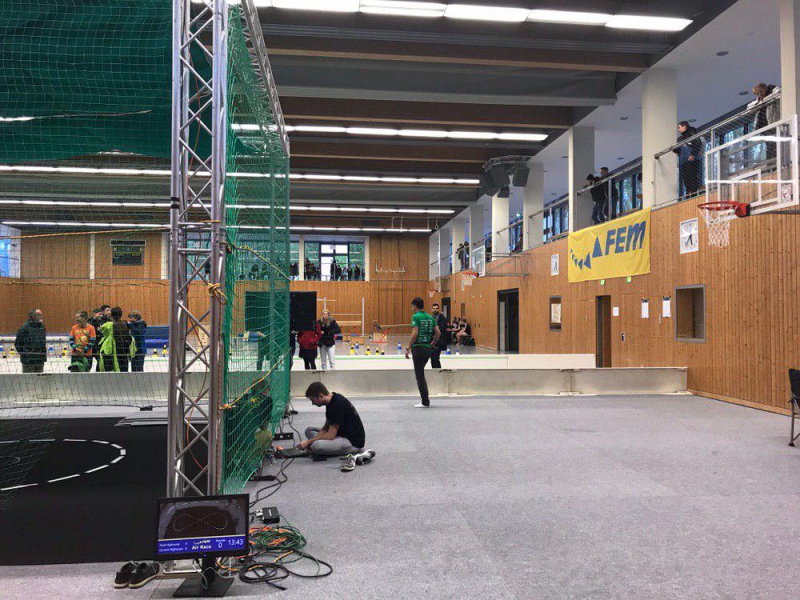
The Mile of Technology finals took place on May 11 in the spacious sports hall of the TU Ilmenau’s campus. Lasting for over 10 hours, they involved two parts: having engaged in competing with each other, the participants then had to present their drones’ abilities before the members of the public attending the festival. As per the rules of the competition, the drones had to fly along dotted lines, circumventing obstacles as they went. Each team was allocated as little as 15 minutes to assemble, fly and disassemble their machine, which, to boot, was supposed to be autonomous. There were also limitations concerning flight altitude: points would only be given if the drones performed their maneuvers at the altitude of 100 to 180 centimeters. They had to avoid touching the nets, posts, and the ground, or restart the race if failed to do so. Places on the winners’ podium went to the teams with the most points.
ITMO’s team brought a total of three drones to partake in the race, including one by the company Geoscan, which started collaborating with the students after their wins on Robotex-2017. It was this drone that ended up bringing the students their third place at the competition. The team missed their shot at gold because of all 13 circles completed by the drone, only two were accepted by the judges: the device failed to comply with the flight altitude requirements.
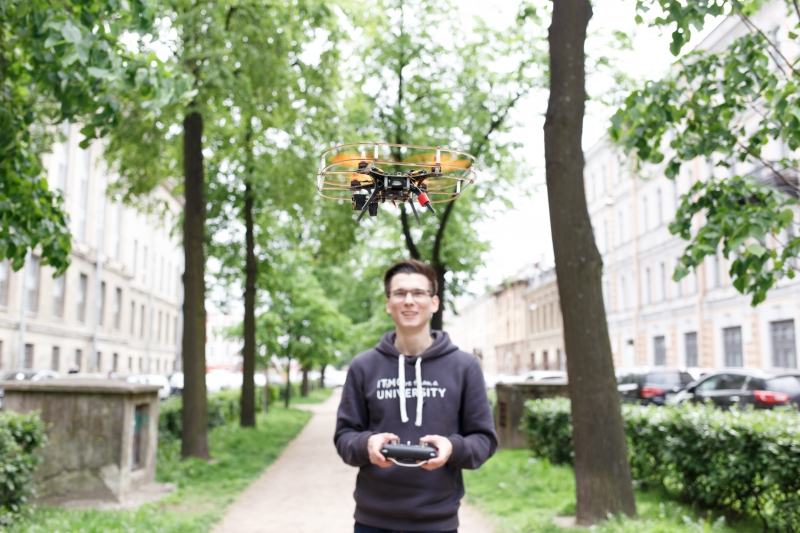
The students blame this on a possible software glitch or faults in the drone’s range measuring device. The drone is coded in the programming language lua, which deprived the team of many opportunities. A drone made by their closest competitor, the team from TU Ilmenau, flew 12 circles, each of which brought the team points.
“Because our drone is programmed in lua, the scope of action we had was very limited. But even so, we’ve managed to make it complete the tasks we set. Maybe those limitations were just an indication that the drone wasn’t simply meant for this kind of tasks. One way or another, it’s a very reliable drone. However much it would crash into the ground, whatever hardships it went through, it didn’t break. Hence the moniker ‘unkaputtable’, which it got from our hosts,” shares Artemiy Zhidkov.
Going forward, the team plans to resolve these limitations through collaboration with the drone’s developers, one of the possibilities for improvement being switching it to C++. The talks have already begun.
Ilmenau’s Long Night of Technology
Happening on the same day but from 5pm was the festival Long Night of Technology (Lange Nacht der Technik). Large-scale both in its scope and the 6km territory it sprawled on, it was for the fifth time that the event was held in Ilmenau’s city center, attracting over 15,000 spectators. The festival’s program included more than 250 activities in 25 different locations.

Sharing in the organization of the annual event are specialists from various faculties and institutes of the Ilmenau University of Technology. Apart from scientific activities, the festival offers a rich cultural program including laser shows, spectacular light installations, and dramatic performances that are full of surprises. One of the past festivals’ theater gigs, a production of Faust, featured the city’s very own vice chancellor, district administrator and minister of science.
But these cultural offerings didn’t distract the spectators from the festival’s main raison d'être: the members of ITMO’s team say that the general public took a great interest towards the robotics tournament.
“It was somewhat unusual to see that many people attending the rather niche Mile of Technology competitions, especially when compared with Robotex’s audience numbers. We were also very impressed by just how well-organized the competition was. Although Ilmenau is not a big city, the organization was on the highest level possible,” says Artemiy Zenkin.
According to the students, participating in robotics competitions like this one is a great opportunity to practice a wide range of skills.

“Unlike standard academic competitions which are more focused towards theoretical knowledge, here you can do something practical and master a lot of nuances as a result. I can compare it to learning a foreign language: it’s really hard at first, but eventually you progress and rise to more complex tasks,” shares Artemiy Zenkin.
He adds that the tasks used on this kind of competitions can be easily adapted to adjacent problems facing robotics specialists in the real world. One example could be the task of fire prevention, as part of which drones can be used to monitor the woodlands. That’s why the competencies gained by participants of robotics tournaments can allow them to fulfil their professional potential at major companies and in a wide range of fields.
Prospects
This year alone, the team plans to take part in a number of other prestigious contests in the field of robotics. If the problems with the Geoscan drone are solved, the students will take it to compete with them as early as this fall. They will also continue their work on the drone by the company Copter Express.
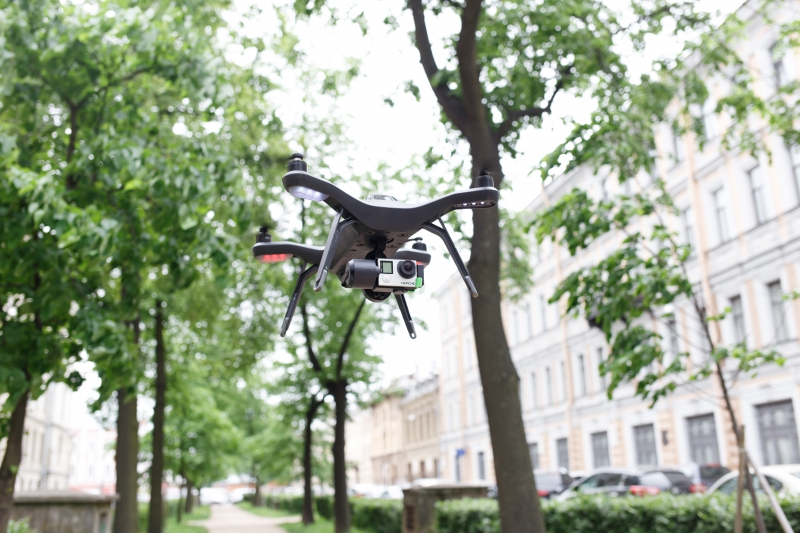
Awaiting the students in the near future, though, are two other major tournaments: Robochallenge and IROS. Robochallenge is a large-scale contest in the field of robotics aimed at students pursuing relevant applied projects, as well as other robotics enthusiasts. This year’s Robochallenge will be held in Bucharest (Romania).
IROS is one of the world’s largest and most important conferences in robotics. It aims to bring together researchers, educators and practitioners from all over the world to discuss the latest advances in the field of intelligent robots and systems.
“The competition that is held as part of IROS is on a whole other level. You have to give it your absolute best to win. The track is very complicated and contains a multitude of different obstacles that are often very unconventional from the technical point of view. Drones have to autonomously map out these obstacles and go full circle without touching anything,” explains Artemiy Zenkin.
The students plan to reproduce this track to train for the tournament, which, together with the parent conference, this year will be hosted on November 3-8 in Macau, China.
